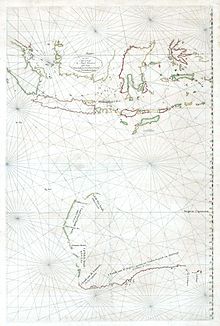Gulden Zeepaert
This article needs additional citations for verification. (August 2015) |
| History | |
|---|---|
| Netherlands | |
| Name | Gulden Zeepaert |
| Owner | Dutch East India Company |
| Launched | Before 1626 |
| Fate | Scrapped |


The Gulden Zeepaert ("Golden Seahorse") was a ship belonging to the Dutch East India Company. It sailed along the south coast of Australia from Cape Leeuwin in Western Australia to the Nuyts Archipelago in South Australia early in 1627.[1][2][3][4]
The captain was François Thijssen.[5]
Details of the voyage
[edit]The Gulden Zeepaert sailed from the Netherlands on 22 May 1626, under the command of Francois Thijssen (sometimes recorded as Thijszoon or Thyssen). Also on board was Pieter Nuyts, extraordinary member of the Dutch East India Company's Council of India, their executive body in the East Indies.
It appears that in January 1627 the vessel encountered the Southland in the vicinity of Cape Leeuwin. Instead of turning north to make for Batavia, as required by Dutch ships of this period, following what is known as the Brouwer Route, it continued along the south coast of Australia for a distance of 1,800 kilometres (1,100 mi). They reached St Francis and St Peter Islands in what is now known as the Nuyts Archipelago, off Ceduna in South Australia.[citation needed] Thijssen mapped the coastline around Fowlers Bay.[6] It has been assumed that one of the trees that was examined during the transit across the south coast of what is now Western Australia, was the Christmas tree (Nuytsia floribunda).[7] The South Australian coast has also been recognized as a point of contact.[8][9] What transpired during this part of the voyage is not known in detail as no log survives. The principal evidence consists of contemporary maps, a brief reference to the voyage in the Daily Register[10] at Batavia for 1627,[11] and in instructions to Gerrit Thomaszoon Pool in 1636 and Abel Tasman in 1644.
The Gulden Zeepaert reached Batavia on 10 April 1627. Records indicate that 30 men died during the voyage. The region they encountered became known as Nuyts Land. Nuyts had also been on board the Leeuwin which sighted and named Cape Leeuwin in 1622. According to the Landings List[12] compiled by the Australia on the Map Division of the Australasian Hydrographic Society,[13] the Gulden Zeepaert was the 13th recorded European contact with Australia.
Notes
[edit]- ^ Chris Halls, The voyage of the Golden Zeepaard. (South Australia, 1971).
- ^ Proceedings of the Royal Geographic Society of Australasia, SA Branch, vol. 72 (1971), p. 19-32.
- ^ Data on trips of the VOC ships Gulden Zeepaard and Valk.
- ^ Michael Pearson Great Southern Land. The maritime explorations of Terra Australis (2005) (published by the Australian government department of the environment and heritage)
- ^ Rees D. Barrett, Significant People in Australia's History, Issue 2 (Macmillan Education AU, 2009)
- ^ "Fowlers Bay, South Australia". 23 November 2007. Retrieved 18 October 2021.
- ^ Ryan, John C (2012), Towards Intimate Relations: Gesture and Contact Between Plants and People, PAN Partners, ISSN 1443-6124
- ^ "Early History of State". The News. Vol. XXVI, no. 3, 938. South Australia. 5 March 1936. p. 17. Retrieved 16 June 2023 – via National Library of Australia.
- ^ "Nuyts Tercentenary". West Coast Sentinel. Vol. XIV, no. 774. South Australia. 3 June 1927. p. 10. Retrieved 16 June 2023 – via National Library of Australia.
- ^ Daily Register
- ^ Heeres, p.51.
- ^ Landings List Archived 2013-11-10 at the Wayback Machine
- ^ Australasian Hydrographic Society
References
[edit]- J. E. Heeres. The Part Borne by the Dutch in the Discovery of Australia, London: Luzac & Co, 1899, p. 51.
